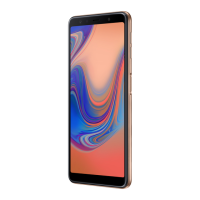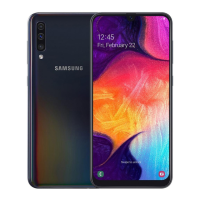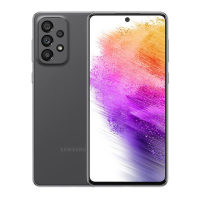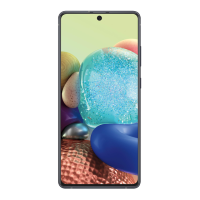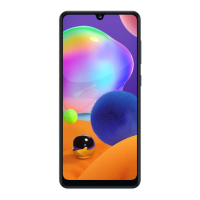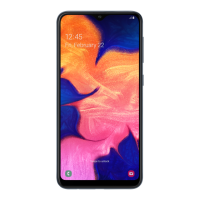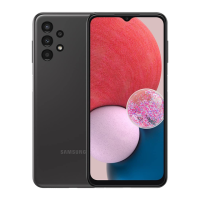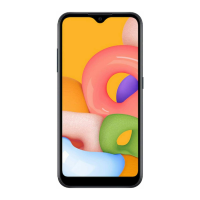Do you have a question about the Samsung Galaxy A71 and is the answer not in the manual?
Essential initial reading for safe and proper device use.
Explains causes of heating and provides troubleshooting steps.
Details the physical components and their purposes.
Covers charging the battery and reducing consumption.
Instructions for installing and managing SIM cards.
Procedures for powering the device on, off, and forcing a restart.
Guides the user through the first-time device setup process.
Information on creating, signing in, and managing a Samsung account.
How to transfer data from a previous device using Smart Switch.
Explains touchscreen gestures and controls.
Overview of the device's main interface screens.
How to lock and unlock the device screen.
How to view and manage notifications and quick settings.
Methods for capturing screenshots and recording the screen.
Keyboard layout, functions, and language settings.
How to download and manage apps from app stores.
Introduction to Samsung's AI assistant.
Using AI for image recognition, translation, and search.
Automating device settings based on usage patterns.
Creating and managing reminders for tasks and events.
Making and receiving calls, managing contacts.
Sending, viewing, and blocking text messages.
Browsing the web and using secret mode.
Taking photos and recording videos with various modes.
Viewing, managing, and editing images and videos.
Creating personalized emojis and stickers.
Viewing information on the screen when it's off.
Accessing favorite apps and features from screen edges.
Running two apps simultaneously in split or pop-up view.
Mobile payment service using MST and NFC.
Managing wellness, fitness, and tracking activity.
Creating and managing notes with text, handwriting, and media.
Managing schedule, events, and reminders.
Organizing and optimizing games.
Enhancing gaming performance and features.
Creating a safe environment for children's device use.
Controlling and managing smart appliances and IoT devices.
Overview of Google applications like Chrome and Gmail.
Manages Wi-Fi, Bluetooth, mobile networks, and other connections.
Connecting to Wi-Fi networks and Wi-Fi Direct.
Pairing and managing Bluetooth devices.
Using NFC for payments and reading tags.
Reducing mobile data usage.
Managing dual SIM card settings.
Sharing the device's internet connection.
Advanced connection options like printing and MirrorLink.
Adjusting volume, ringtones, and sound effects.
Customizing notification sounds, badges, and alerts.
Configures screen brightness, color modes, and visual appearance.
Manages home screen layout, edge screen, and navigation bar.
Settings for screen lock types, smart lock, and notifications.
Unlocking the device based on trusted locations or devices.
Securing the device with face, fingerprint, and software updates.
Registering and using fingerprints for device security.
Managing biometric data for secure logins and autofill.
Protecting private content and apps in a separate secure area.
Encrypting network connections for safe browsing.
Managing app permissions and data sharing settings.
Configuring location services and app permissions.
Syncing accounts and backing up data via Samsung Cloud.
Accessing specialized device functionalities.
Accessing device data on a Windows computer.
Using device movements for shortcuts and controls.
Using two accounts for the same messaging app.
Monitoring device usage and setting parental limits.
Overview of device status and optimization.
Managing installed applications and their settings.
Customizing system settings and device reset options.
Enhancing device usability for various needs.
Updating the device's operating system and security patches.
Solutions for common device issues and error messages.
Common problems with battery charging and depletion.
Troubleshooting Bluetooth, network, and data loss problems.
Addressing physical gaps, button visibility, and brightness bar.
Warnings and instructions regarding battery removal.
| Color name | PRISM CRUSH BLUE |
|---|---|
| Form factor | Bar |
| Product color | Blue |
| Screen shape | Flat |
| Pixel density | 393 ppi |
| Display diagonal | 6.7 \ |
| Touch technology | Multi-touch |
| Touchscreen type | Capacitive |
| Display resolution | 1080 x 2400 pixels |
| Native aspect ratio | 20:9 |
| Fingerprint resistant | Yes |
| Display number of colors | 16 million colors |
| Processor cores | 8 |
| Processor model | 730 |
| Processor family | Qualcomm Snapdragon |
| Coprocessor cores | - |
| Processor frequency | 2.2 GHz |
| Coprocessor frequency | 1.8 GHz |
| User memory | 106.1 GB |
| RAM capacity | 6 GB |
| Memory card slot type | Dedicated slot |
| Compatible memory cards | MicroSD (TransFlash) |
| Maximum memory card size | 512 GB |
| Internal storage capacity | 128 GB |
| Flash type | LED |
| Digital zoom | 8 x |
| Rear camera type | Quad camera |
| Front camera type | Single camera |
| Maximum frame rate | - fps |
| Video recording modes | 720p, 1080p, 2160p |
| Rear camera pixel size | 0.8 µm |
| Rear camera sensor size | 1/1.7 \ |
| Front camera sensor size | 1/2.8 \ |
| Rear camera aperture number | 1.8 |
| Resolution at capture speed | 1280x720@240fps, 3840x2160@30fps |
| Video capture resolution (max) | 3840 x 2160 pixels |
| Rear camera resolution (numeric) | 64 MP |
| Front camera resolution (numeric) | 32 MP |
| Fourth rear camera aperture number | 2.4 |
| Second rear camera aperture number | 2.2 |
| Third rear camera resolution (numeric) | 5 MP |
| Second rear camera resolution (numeric) | 12 MP |
| 4G standard | LTE |
| 2G standards | EDGE, GPRS, GSM |
| 3G standards | UMTS, WCDMA |
| SIM card type | NanoSIM |
| Wi-Fi standards | 802.11a, 802.11b, 802.11g, Wi-Fi 4 (802.11n), Wi-Fi 5 (802.11ac) |
| Bluetooth version | 5.0 |
| 3G bands supported | 850, 900, 1900, 2100 MHz |
| 4G bands supported | 700, 800, 850, 900, 1800, 1900, 2300, 2500, 2600 MHz |
| SIM card capability | Dual SIM |
| 2G bands (primary SIM) | 850, 900, 1800, 1900 MHz |
| Mobile network generation | 4G |
| Subscription type | No subscription |
| USB version | 2.0 |
| USB connector type | USB Type-C |
| Headphone connectivity | 3.5 mm |
| Mobile High-Definition Link (MHL) | No |
| Multimedia Messaging Service (MMS) | Multimedia Messaging Service (MMS) is a standard way to send messages that include multimedia content to and from a mobile phone over a cellular network |
| Themes | Wallpapers |
| Graphics card | Adreno 618 |
| Personalization | Icons, Menu, Shortcuts |
| Personal info management (PIM) | Alarm clock, Calculator, Calendar, File manager, Notes |
| Audio formats supported | 3GA, AAC, AMR, AWB, FLAC, IMY, M4A, MID, MIDI, MP3, MXMF, OGA, OGG, OTA, RTTTL, RTX, WAV, WMA, XMF |
| Video formats supported | 3G2, 3GP, ASF, AVI, FLV, M4V, MKV, MP4, WEBM, WMV |
| Platform | Android |
| Virtual assistant | Samsung Bixby |
| Google applications | Gmail, Google Chrome, Google Maps, Google Play, YouTube |
| App distribution platform | Google Play |
| Operating system installed | Android 9.0 |
| Talk time (3G) | - h |
| Battery capacity | 4500 mAh |
| Browsing time (Wi-Fi) | 16 h |
| Continuous audio playback time | 107 h |
| Continuous video playback time | 24 h |
| Body SAR (EU) | 1.562 W/kg |
| Head SAR (EU) | 0.512 W/kg |
| Repairability index | 8.2 |
| Depth | 7.7 mm |
|---|---|
| Width | 76 mm |
| Height | 163.6 mm |
| Weight | 179 g |
